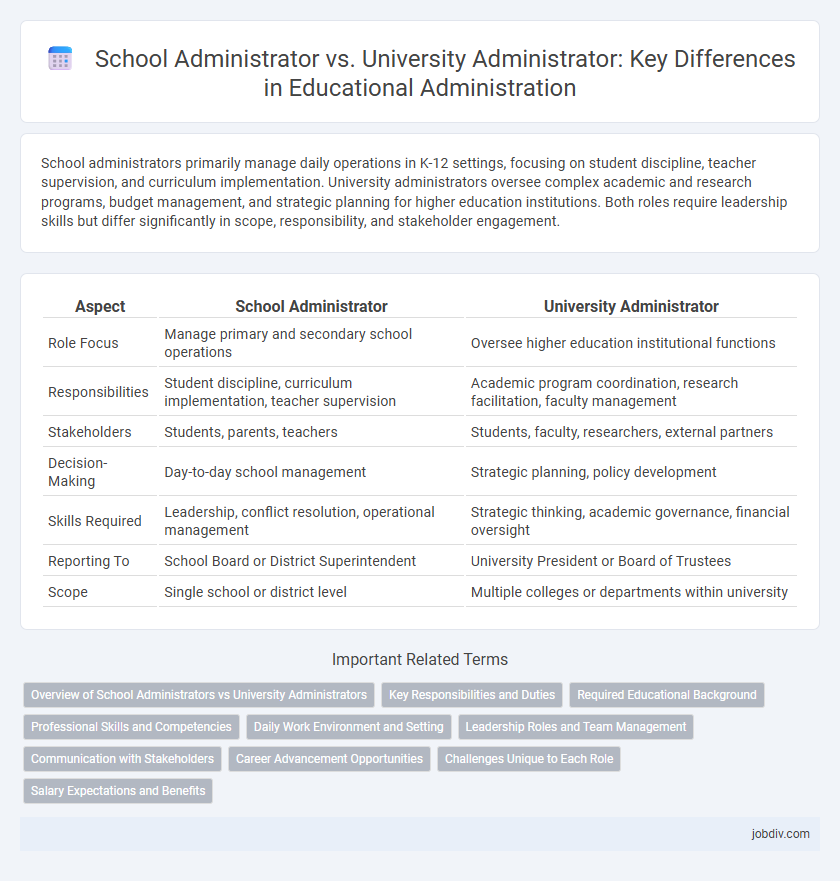School administrators primarily manage daily operations in K-12 settings, focusing on student discipline, teacher supervision, and curriculum implementation. University administrators oversee complex academic and research programs, budget management, and strategic planning for higher education institutions. Both roles require leadership skills but differ significantly in scope, responsibility, and stakeholder engagement.
Table of Comparison
| Aspect | School Administrator | University Administrator |
|---|---|---|
| Role Focus | Manage primary and secondary school operations | Oversee higher education institutional functions |
| Responsibilities | Student discipline, curriculum implementation, teacher supervision | Academic program coordination, research facilitation, faculty management |
| Stakeholders | Students, parents, teachers | Students, faculty, researchers, external partners |
| Decision-Making | Day-to-day school management | Strategic planning, policy development |
| Skills Required | Leadership, conflict resolution, operational management | Strategic thinking, academic governance, financial oversight |
| Reporting To | School Board or District Superintendent | University President or Board of Trustees |
| Scope | Single school or district level | Multiple colleges or departments within university |
Overview of School Administrators vs University Administrators
School administrators oversee the daily operations, staff management, and student services in K-12 educational institutions, focusing on curriculum enforcement, discipline, and community engagement. University administrators manage broader responsibilities including academic policies, faculty coordination, research programs, and campus planning at higher education institutions. The scope of university administration is typically more complex, reflecting the larger scale and diverse functions of universities compared to schools.
Key Responsibilities and Duties
School administrators oversee the daily operations of K-12 institutions, managing staff coordination, student discipline, and curriculum implementation to ensure compliance with educational standards. University administrators focus on higher education governance, including faculty management, research oversight, budget allocation, and policy development to support academic programs and institutional goals. Both roles require strong leadership, strategic planning, and communication skills tailored to their specific educational environments.
Required Educational Background
School administrators typically need a bachelor's degree in education or educational leadership, often supplemented by state-specific administrative credentials or certifications. University administrators usually require a master's degree or doctorate in higher education administration, business administration, or a related field, reflecting the complexity of managing large academic institutions. Advanced knowledge in policy development, financial management, and strategic planning is essential for university roles, while school administrators focus more on curriculum standards and community engagement.
Professional Skills and Competencies
School administrators excel in managing K-12 educational settings by demonstrating strong skills in student discipline, curriculum implementation, and parent communication, ensuring a safe and effective learning environment. University administrators require advanced competencies in higher education policies, research oversight, faculty coordination, and complex budgeting to support diverse academic programs and institutional goals. Both roles demand leadership, strategic planning, and knowledge of educational regulations, yet university administrators often engage more with governance and academic affairs.
Daily Work Environment and Setting
School administrators typically manage K-12 environments where daily routines include close interaction with teachers, students, and parents, focusing on operational tasks such as scheduling, discipline, and curriculum implementation. University administrators operate within a higher education setting, navigating complex structures involving faculty governance, research oversight, and student services across diverse departments. The school administrator's workday is often more structured and community-centered, whereas university administrators handle broader strategic planning and policy development in a larger, more decentralized environment.
Leadership Roles and Team Management
School administrators primarily lead faculty and staff within K-12 settings, focusing on curriculum oversight, student discipline, and community engagement. University administrators manage broader teams including academic departments, research staff, and administrative units, emphasizing strategic planning, policy development, and resource allocation. Both roles require strong leadership skills, but university administrators often handle more complex organizational structures and higher education governance.
Communication with Stakeholders
School administrators communicate regularly with parents, teachers, and local community members to ensure alignment with educational goals and address immediate concerns. University administrators engage with a broader range of stakeholders, including faculty, research staff, funding bodies, and international partners, requiring more complex communication strategies. Effective stakeholder engagement in both settings is essential for policy implementation, resource allocation, and fostering collaborative environments.
Career Advancement Opportunities
School administrators typically have opportunities to advance into district-level positions such as superintendent or curriculum director, leveraging experience in K-12 education management. University administrators can progress into senior roles like vice president of administration or dean, often requiring specialized knowledge in higher education policies and research administration. Career growth in both fields benefits from leadership skills, but university administrators usually encounter more diverse paths due to the complexity of postsecondary institutions.
Challenges Unique to Each Role
School administrators face challenges such as managing limited budgets, addressing diverse student needs, and ensuring compliance with K-12 education policies. University administrators encounter complexities related to coordinating research initiatives, handling faculty governance, and navigating higher education accreditation standards. Both roles require strategic planning and leadership, but the scale and scope of responsibilities differ significantly.
Salary Expectations and Benefits
School administrators typically earn an average salary ranging from $60,000 to $90,000 annually, depending on the district and state, while university administrators often command higher salaries starting from $70,000 to over $120,000 due to larger institutional budgets and additional responsibilities. Benefits for school administrators commonly include health insurance, retirement plans, and paid leave, whereas university administrators may receive similar benefits along with tuition remission, research grants, and professional development funds. Both roles demand strong leadership and organizational skills, but university administrators usually have access to more extensive resources and perks tied to higher education environments.
School Administrator vs University Administrator Infographic

 jobdiv.com
jobdiv.com